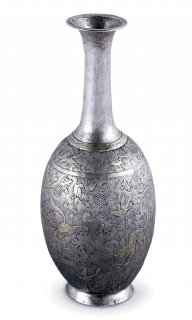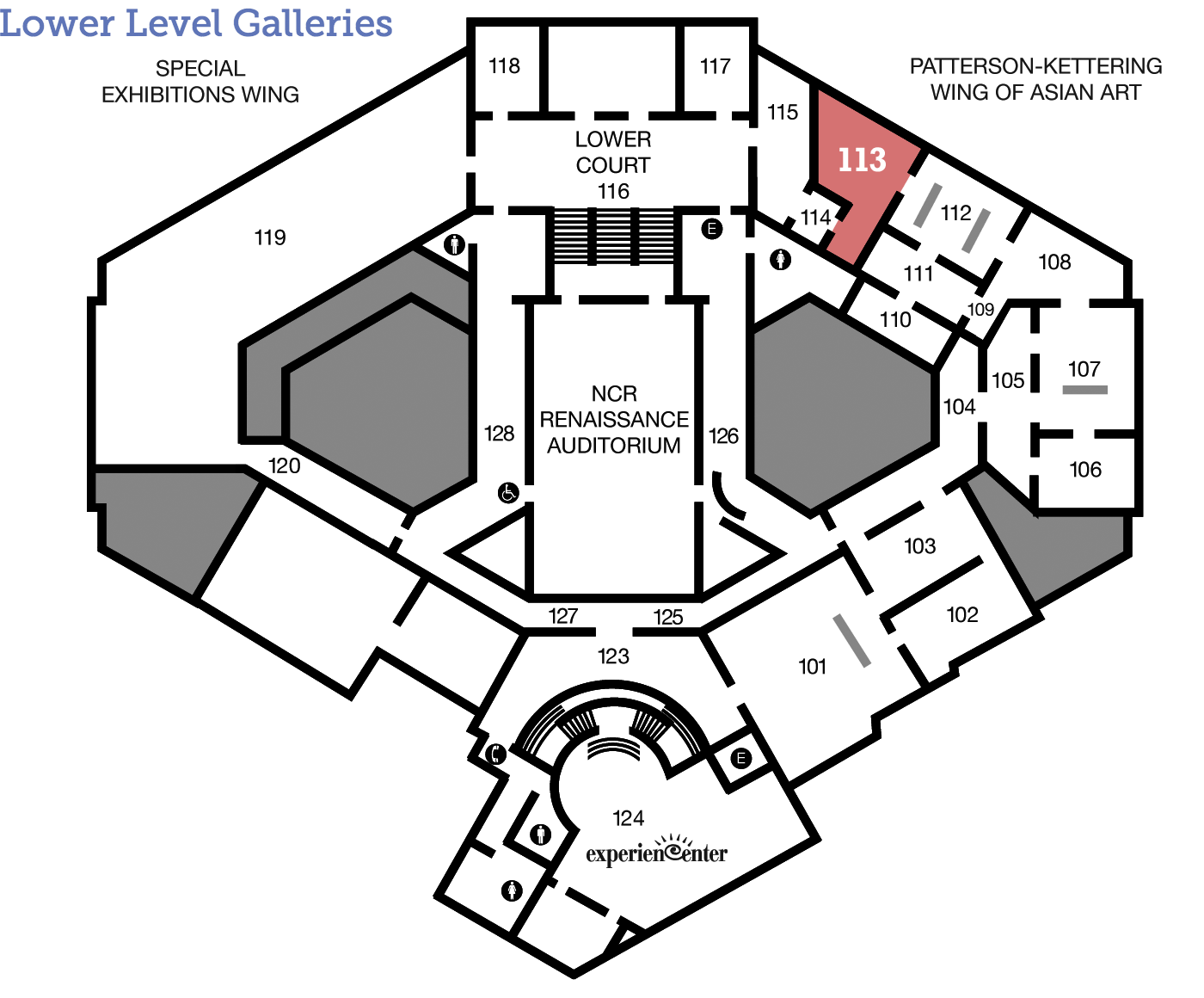
Chinese
Ritual Bottle
(Tang dynasty (618–906))
Chinese Early 8th century Silver with gold inlay 7 ½ x 3 x 3 inches Gift of Mrs. Harrie G. Carnell 1935.23
An Adventurous Artifact
Gold, gunpowder, and raising the dead. No, it is not another Indiana Jones movie. This rare silver and gold bottle is overflowing with fascinating facts and deadly details from one of the great eras of world history, the Tang dynasty.
A Day in the Life
Message in a Bottle
The Silk Road was at its peak during China’s Tang dynasty, when this bottle was made. For over one thousand years travelers risked their lives crossing massive deserts and deadly terrain to bring caravans of paper, silk, gunpowder, and porcelain from China to the rest of the world. The organization and stability of the Tang dynasty not only fostered the creation of art, but the incorporation of artistic motifs and forms from outside cultures into that art.
For example, this vessel is based on a shape from India. Often depicted in the hands of Hindu or Buddhist spiritual figures, the bottle was a container for ambrosia, or “water of life,” which could give new life to the deceased. In China, it was called baoping (ambrosia bottle) and was frequently depicted in the hand of the bodhisattva of compassion Guanyin, such as the example below. However, while the bottle has spiritual roots it also simply became a popular shape for vessels in China. The grape and lion motif on this bottle was also brought from another culture. To find out where, go to “Signs & Symbols.”
Tools and Techniques
Precious Metals
The silver and gold used in this baoping give us a clue as to why it is so rare today. Silver and gold are very scarce natural resources to China, which means that the metals used in this baoping would have been imported from outlying provinces and foreign territories. The prosperity, stability and peace of the Tang dynasty as well as the trade flowing through China as part of the Silk Road meant that luxury metals were cropping up in China, and Chinese artists used them to display their technical brilliance as never before.
However, as the peace of the Tang dynasty began to descend into rebellion and chaos—starting with the An Lushan rebellion in 755 CE—the availability of precious metals declined and the government restricted production. At the same time, popular vessels in the baoping shape were also produced in ceramics, such as the example below.
Further reading: Clarence W. Kelley, Chinese Gold & Silver in American Collections (Dayton, OH: The Dayton Art Institute, 1984), 81–82.
Behind the Scenes
Look Closer
Just for Kids
Imagine!
Where does your shirt come from? Does it come from a different country? How do you think your shirt made its way to you? Imagine you lived 1000 years ago. If you wanted a shirt from China, how would you get it? Think about what kind of transportation existed before cars, planes, and trains. How long do you think it would take to get your shirt from China?
During the Tang dynasty in China, many merchants traveled on the Silk Road. The Silk Road stretched across Europe to Asia, allowing civilizations to trade with one another. This ritual bottle was made during this time and was inspired from different cultures.
Signs & Symbols
Grape Expectations
Look closely at the intricate details on the surface of this vessel; notice the frisky felines and birds entangled among the leafy vines and clumps of grapes. This motif of grape vines with lions can be traced back to the Near East and Mediterranean and is associated with the Manichean religion, which came to Tang China in 694 CE. However, the significance of grapes is also related to wine in China, as former DAI Asian Art Curator Clarence W. Kelley observes:
The grape had been introduced to China during the Han period by the traveler Zhang Qian, but remained a relatively unimportant crop until the Tang period. Alcoholic beverage was a rare and exotic drink. Tang expansion into Serindia, however, brought a renewed interest in wine making with the introduction of a new grape variety and technique in AD 647. To the Chinese, the grape’s Western spiritual dependences were substituted to represent symbolic evidence of Chinese luxury and richness, and for this the ambrosia bottle was particularly appropriate.
Clarence W. Kelley, Chinese Gold & Silver in American Collections (Dayton, OH: The Dayton Art Institute, 1984), 83.
Dig Deeper
An Explosive Time
The Tang dynasty (618-906) produced many great cultural objects, such as this bottle, but it was also a time of great inventions. Listen as Robert Jacobsen, former Curator of Asian Art at the Minneapolis Institute of Arts, discusses one that you are certainly familiar with.
Credit: © Minneapolis Institute of Arts
Transcript:
The Tang was a highly creative period. Probably the most important invention in terms of worldwide impact would be the invention of gunpowder. Within the Tang dynasty the Chinese go on to use gunpowder to invent the rocket. The two-stage rocket is invented in the next dynasty, the Sung. Eventually they invent what we would call small firearms, and then the cannon. The cannon travels to the West under the period of Genghis Khan in 14th century during the Yuan period. So the invention now of gunpowder, the firecracker, and the rocket, and these were used in celebrations as they still do with firecrackers today, as well as in military conflict and warfare. This was a new invention that goes on to have great impact on humankind throughout the globe.
This is a period of wonderful painting, of brilliant sculpture, of very, very fine architecture; both palatial, as well as temple construction continues. The stone sculpture, the bronze sculpture in Buddhist traditions, especially is very notable. The pictorial arts prosper as well. The court itself is involved with some of that certainly and there is, not the invention, but certainly the evolution of Chinese landscape painting begins to take place at this time. And we can see painting take two different directions. One, the more didactic, descriptive, colorful type of painting and the other the pure ink painting. Both of these are rooted in the Tang pictorial traditions.
So, it was a rich, opulent period for the arts and the Chinese see the Tang dynasty, which comes to an end in 906, as one of the true Golden Ages of their long and distinguished history.
Arts Intersected
The Sculpture Speaks
Did You Know?
Expert Opinion
Look Around
Tight and Loose
If you are in the galleries, compare this bottle with some of the nearby ceramics from the same time period, such as the jar with yellow, green, and blue diamond-like shapes. This is an example of the sancai or “three-color” glazing technique mastered during the Tang era. The colored lead glazes are applied with a wax-resist technique that melts during the firing process. This produces a variety of patterns and blended colors that are unique to each piece. Compared to the tight, detailed silver bottle, the jar shows a looser but equally engaging side of Tang craftsmanship.
About the Artist
Talk Back
A Rare Treat
This bottle is now one of only four in Euro-American collections. How does knowing that it is rare affect the way you see it? Does the rarity of an object make it any more or less of a masterpiece?

